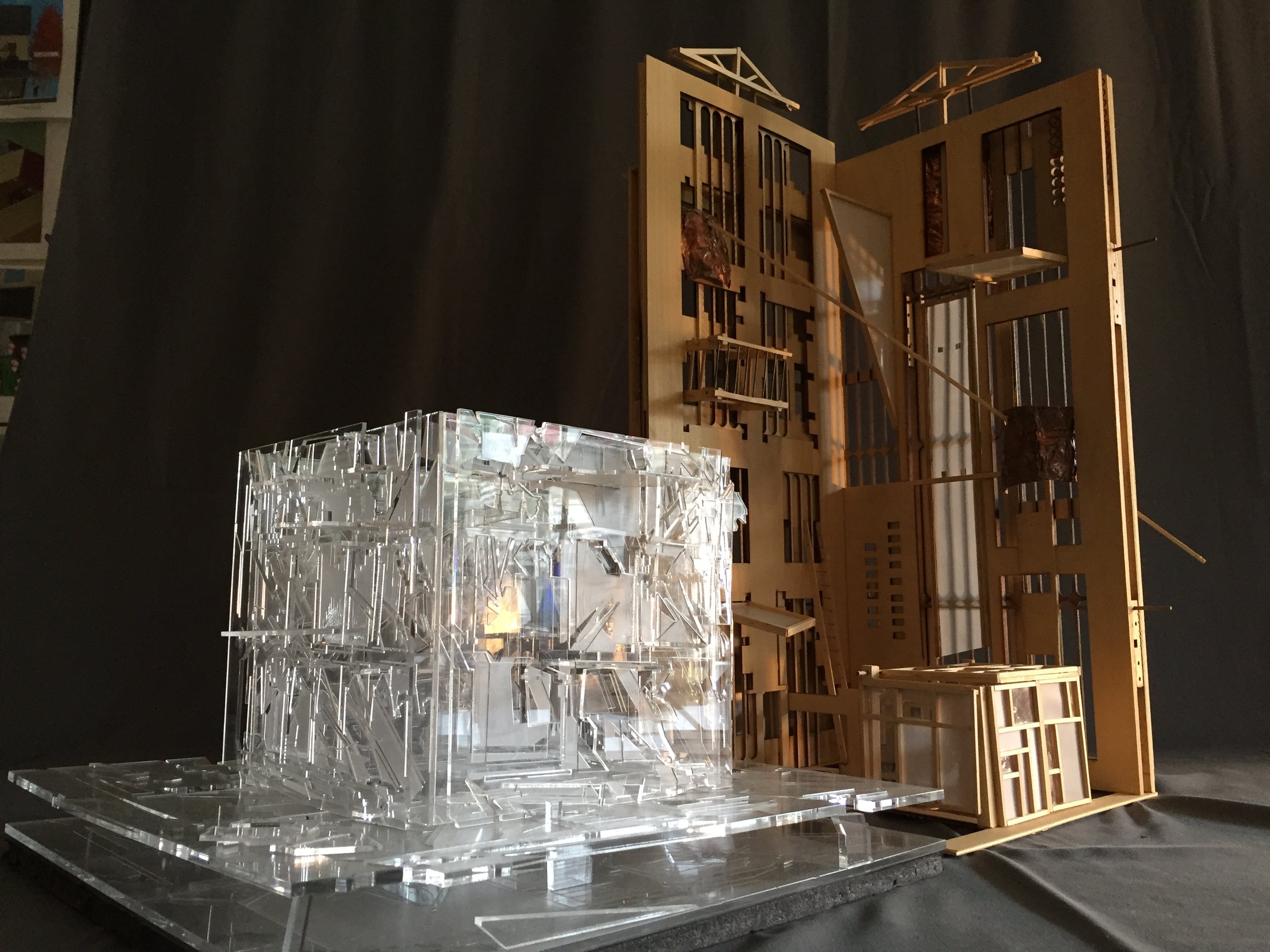
On the stage of this theatre, shadows are the required sustenance for our memory. Shadows describe objects at rest making possible projections which speak of absent objects, objects which belong to memory and therefore to the power of imagination.
Quoted from Marco Frascari, A Secret Semiotic Skiagraphy: The Corporeal Theater of Meanings In Vincenzo Scarmozzi’s Idea of Architecture
Shadow Projection Machine–Tracing Time to Measure Space
The significance of the original model, the Shadow Projection Machine—a sort of sundial—exists only in its role as the precipitator of its trace. It is constructed over time in improvisational play with its ever-changing shadow, unfolding in answer to the artist’s question, “If an object can cast a shadow, can a shadow cast an object?” When the tracing is complete, the Shadow Projection Machine is dismantled, leaving only a Shadow Map of its former existence as the indicator of time and measurement. The planes and volumes transposed from these shadow lines record the interplay of the object with its shadow. In this form of reiterative exploration, the map is used as a means to decipher three-dimensional casts of the shadow, physical constructs of its projections and trajectories, as well as interpretive palimpsests of drawings.
Constructing the Shadow
The accidental becomes essential...
shepherding the shadows like an archivist
of the accidental, or a curator of the contingent.
Quoted by Gordon Bearn, philosopher and friend
Orthographic projection in drawing immediately establishes an association between plan and section. This correlation can be analogous to the relationship between the object and the shadow but only in reverse. Designed objects are projected from two-dimensional plans (the shadow) to create three-dimensional forms (the object). The following three architectonic constructions interact and transform the meaning and interpretation of space and time in response to light’s projection. Each of these intimate structures can be seen as templates from which to construct large-scale architectural spaces informed by material explorations in metal, glass, wood, concrete, and the like.
The Sundial
The character of a shadow assumes the form of the surface upon which it falls, demonstrating that, even though the shadow comes from its object (the gnomon), it belongs to the surface on which it falls. In this work, the form of the shadow, captured as it traversed the topography of the plaster cast, is incised into the surface to excavate a new foundation from which to imagine a new object.
The Shadow Box
This re-construction of the opaque shadow, cut from thin plywood, alludes to forms as they are captured in a seemingly endless dimension of the box. Here the reiterations of shapes disfigure the wall, similar to the way tree branches in the winter cut phenomenological impressions of the shadow into the structural facade of a building.
The Light Projecting Cube
As the shadow assumes a crystalline form cut from Plexiglas plates and assembled to form a cube, it is transmuted to become a light-projecting object. The reflection and refraction of light through shadow form releases the imagination to inhabit new realms of possibility. Consider this form constructed in glass where light and water may collude to alter perceptions of space and time.
The Architect
The steel sculpture is a large version of the original basswood model. It was the first shadow model that initiated my creative research into the power of the shadow. It became the focus of an entire body of work including ink drawings, airbrush paintings, monoprints and itaglio prints and 3D laser cut constructions.
Model, Drawing and Reversal Print
Metal sculpture 9’ X 5’ X 2’ fabricated by Eli Hess [former student]
Shadow Model 1, 2012, Wood and Mylar construction, 36” x 42” x 36”
Shadow Model 1 (detail), 2012, Wood and Mylar construction, 36” x 42” x 36”
Light Cube, 2013, Plexiglass, 18” x 18” x 18”
Light Cube (Interior View), 2013, Plexiglass, 18” x 18” x 18”
Light Cube, 2013, Plexiglass, 18” x 18” x 18”
The Shadow Box, 2013, Laser cut plywood, 18” x 25” x 5”
The Sundial (detail), 2013, Plaster and wood construction, 12” x 46”
The Sundial, 2013, Plaster and wood construction, 12” x 46”






![metal sculpture 9’X5’X2’ fabricated by Eli Hess [former student]](https://images.squarespace-cdn.com/content/v1/61eb11cfc97086774fcff590/d314090f-8ccf-4483-be6b-b47f2bc99c32/5.+THE+ARCHITECT+Metal+Sculpture.jpg)









